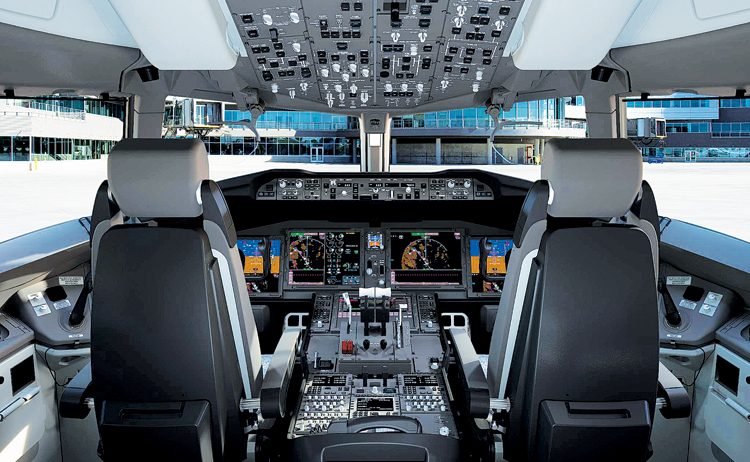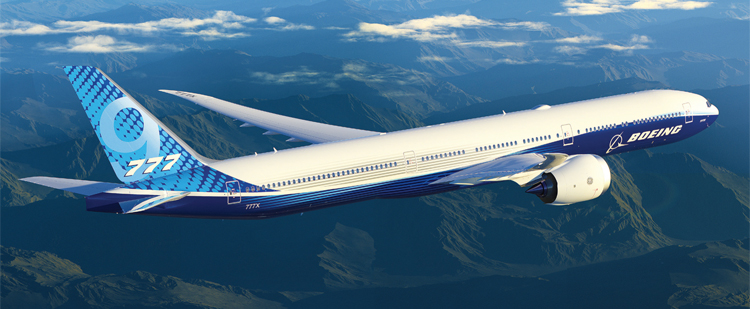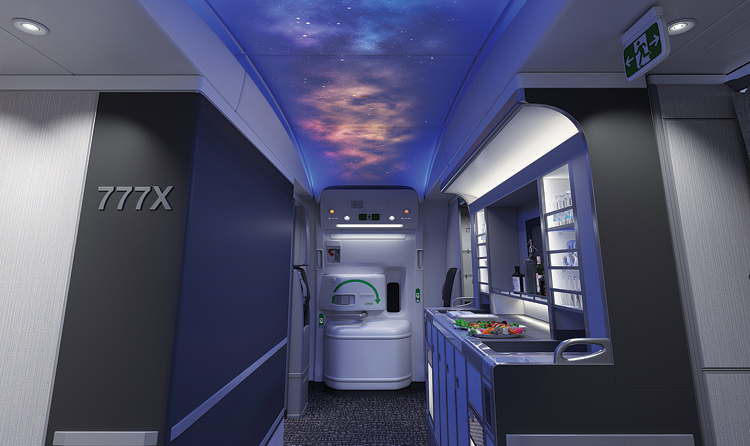Boeing 777X: The Largest and Most Efficient Twin-Engine Jet
The new Boeing 777X is claimed to be the world’s largest and most efficient twin-engine jet

One aircraft that was viewed most attentively during the mid-November Dubai Airshow was the Boeing 777X. The demonstration of steep vertical take-off enthralled the awe-inspired crowds. The aircraft also attracted attention of prospective operators and aviation analysts. The new Boeing 777X is claimed to be the world’s largest and most efficient twin-engine jet. Built around new breakthroughs in aerodynamics and engines, the 777X will have ten per cent lower fuel consumption, emissions and lower operating costs than its equivalents. It will also seamlessly integrate with operations of the 777 and 787 Dreamliner. The more spacious airliner borrows new custom architecture and innovations from the 787 Dreamliner.
IMPORTANT FEATURES
This long-range, wide-body, twin-engine jetliner features the new GE9X engines, new composite wings with folding wingtips, greater cabin width and seating capacity. The new carbon-fibre-reinforced-polymer (CFRP) wing has a span of 213ft or 225ft with blended winglets or up to 233ft 5in with raked wingtip provide for ten per cent larger wing area. The folding wingtips are meant to reduce wing span for ground operations. With folding wingtips it would stay within the 213ft 4in ICAO aerodrome code E requirements like the current 777s. Interestingly, the larger span 747-8 and A380 are in the higher code F. The wing design is based on the 787 wing, but with lesser sweep. The new wing has both higher lift-to-drag ratio and aspect ratio. The folding movement takes 20 seconds. As existing regulations did not cover the folding wingtips, the FAA had to formulate special conditions, including proving their load-carrying limits, demonstrating their handling qualities in crosswind conditions when raised.
DEVELOPMENTAL BACKGROUND
The aircraft idea sprung in 2011 as a response to the revamped airbus A350XWB with three 777X models, targeting a firm configuration in 2015, flying in late 2017 or 2018 and entering service by 2019. The 777X was launched in November 2013 with two variants: the 777-8 and the 777-9. The 777-9 first flew on January 25, 2020, with deliveries expected to commence in 2024.
ENGINE CHOICE
The 777-200LR and 300ER variants are powered by GE90-115B engines with 42:1 overall pressure ratio. Rolls-Royce proposed its RB3025 concept with a 62:1 overall pressure ratio, and targeted ten per cent lower fuel burn than the GE90-115B. GE Aviation alternatively proposed the GE9X with a 128in diameter fan and 60:1 overall pressure ratio. Finally, in 2013, Boeing selected the GE9X with a 132 in fan, the largest fan made by GE.

WIDER CABIN
The internal cabin width is increased from the previous 777 models by four inches from 231 to 235 inches. This is done through thinner but better insulated interior cabin walls. This allows 18-inch wide seats in ten-abreast economy. Larger windows, higher ceilings, more humidity and lowered cabin altitude to 6,000 ft, are some of the other features. The windows are dimmable.
VARIANTS
The 777-300ER (ER for Extended Range) is 242.4ft long and with Maximum Take-Off Weight (MTOW) of 775,000 lb and 396 passengers. The 777-200LR (LR for Long Range), the C-market model entered service in 2006 as one of the longest-range commercial airliners. It made a record longest nonstop flight by a passenger airliner by flying 11,664 nautical miles from Hong Kong to London, lasting 22 hours and 42 minutes.
The 777-200LR, the C-market model entered service in 2006 as one of the longest-range commercial airliners
The 426–passenger 777-9 would essentially stretch the 777-300ER by four frames to 250ft 11in in length and a 759,000 lb MTOW. It was to be powered by 99,500 lbf engines targeting per-seat 21 per cent lower fuel burn and 16 per cent lower operating cost. The 777-9 has a range of 7,285 nm. The 777-9 requires less thrust than the current 777-300ER because the wings produce more lift than the original 777. But even with less thrust, there is no loss in speed.

The 777-8 is a shortened derivative of the 777-9, 229 ft long and seats typically 384 passengers with a range of 8,730nm. With a 6,94,000 lb MTOW and powered by 88,000 lbf turbofans, it would compete with the A350-900. Boeing forecast a 33 per cent better cost per seat than the 747-400 and 13 per cent better than the 777-300ER. However, the Airbus A350-900 and the 777-9, both claim to consume an average of 2.9L/100 km per passenger. Boeing is further proposing to stretch the -9 by four rows of seats to accommodate 450 passengers in a 777-10X variant to compete with the Airbus A380 superjumbo.
ORDER BOOK
On September 18, 2013, Lufthansa became its launch customer by opting for 34 Boeing 777-9X. More orders flowed at the November 2013 Dubai Airshow for the -8X and the larger -9X with commitments for $95 billion at list prices. Emirates, Cathay Pacific, All Nippon Airways, Singapore Airlines, British Airways, Qatar Airways and Etihad Airways also placed orders. Boeing dropped the ‘X’ suffix of the variants, while keeping the 777X programme name in 2015. Due to its larger order (140 aircraft), Emirates will become the first operator instead of Lufthansa. As of 2021, there are 351 total orders for the 777-8 and 777-9 from eight identified customers and other buyers.
GROUND AND FLIGHT TESTING
Four -9s, a fatigue-test airframe and two -8s were planned for testing. Tests of avionics, power and integrated systems continued in Boeing laboratories. The 777-9 production was launched in October 2017. 99 per cent of the wing and fuselage drawings were released by end-2017. By September 2018, the static test 777X was ready. The first aircraft for flight test was completed by end 2018. The roll-out of the prototype happened in March 2019. The GE9X engines installed on the 777X prototype were first run in May 2019. There were some initial engine test issues. In June, the first prototype began low-speed taxi tests. By late 2019, the other four 777-9 prototypes were undergoing assembly.
The 777X is meant to give an all-new passenger experience
In September 2019, in the presence of FAA inspectors, a cargo door blew off on the 777X static test airframe during the ultimate load test. This and the engine issues added delays. Also, fatal crashes of the Boeing 737 MAX raised issues for similar components installed on the 777X. Finally, the first test flight took place on January 25, 2020. It was a three-hour and fifty-two minute flight. The second 777X first flew on April 30. The third test aircraft made its maiden flight on August 3, 2021. A typical flight test could have around 120 engineers onboard collecting data, monitoring the aircraft’s systems and ensuring the plane is doing what it is supposed to. Boeing is giving the 777X a flight testing schedule of 44 months, nearly four times longer than the original 777, which it says will help it work out any issues, make changes and account for regulator inputs. Boeing has planned around 3,500 hour’s flight test programme. The COVID-19 had also delayed the programme. The type certification could complete around mid to late 2023, pushing deliveries to 2024.

BBJ AND FREIGHTER VARIANTS
In 2018, Boeing launched Boeing Business Jet (BBJ) variants of 777. The BBJ 777-8 offers a range of 11,645 nautical miles and a 3,256 sq ft cabin, while the BBJ 777-9 provides a 3,689 sq ft cabin and a range of 11,000 nautical miles. At one point, the 777-9 was a contender for the US Air Force’s Presidential aircraft, the ‘Air Force One’. Finally, the Boeing 747-8 was selected because of the four engine requirement. In June 2019, Qatar Airways urged Boeing to develop a 777X-based freighter to replace its existing 777Fs. The freighter is expected to be based on the 777-8 airframe. This is yet to be finalised.
Boeing is developing a 777X-based freighter to replace its existing cargo planes. The freighter is expected to be based on the 777-8 airframe but is yet to be finalised
777X – THE VALUE PROPOSITION
The 777X is meant to give an all-new passenger experience. Unconstrained longer composite wingspan, even larger than the A350-1000, that results in better Lift/Drag ratio and better aerodynamics. Laminar flow nacelles reduce drag. The folding wing enables high-span efficiency while maintaining taxiway and gate compatibility. The aircraft has composite floor beams and empennage. It also features advanced flight controls and high lift design. Exclusive GE clean-sheet engine and other modern technologies give better Specific Fuel Consumption. It means ten per cent lower fuel costs even when compared to the -300ER. The engine has 15 db noise levels well within stage four margin and 29 per cent emissions within CAEP/8 margin. The flightdeck has all touch screen displays and commands. Pilots can use their iPads, known as electronic flight bags, to show charts on the cockpit’s screens. The enhanced cabin environment allows lower cabin altitude, improved humidity, cleaner air, improved temperature control, lower cabin noise, and smoother ride. The 777X offers a wider cabin for increased seating space and flexibility and lower operating costs, albeit the 3-4-3 seating configuration will remain.
By the time, the 777X enters service Boeing will have stopped producing the 747. It will be the first time since the 1950s that Boeing will have no four-engine jets in production. It will still be at least two more years before any paying passenger can board the 777X. The 777-9 will be the first of the two aircraft to enter service, with a range of 7,285 nautical miles and a maximum capacity of 426 passengers.
The author is a well known expert on Aviation and has authored many articles on Commercial Aviation and Aerospace.





